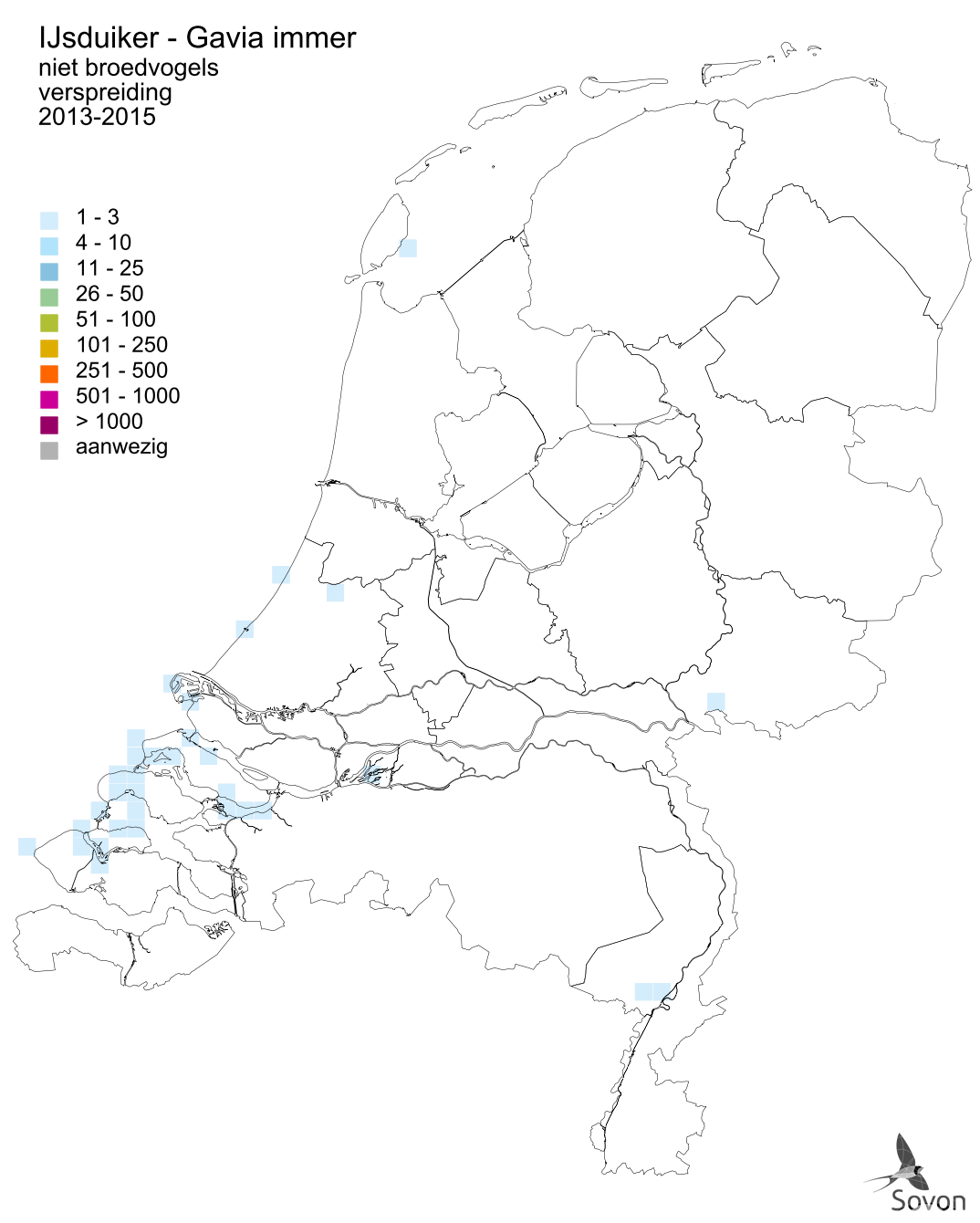Verspreiding en trends
Verspreiding

Deze kaart is gebaseerd op de Vogelatlas van Nederland (Sovon 2018). Per atlasblok van 5x5 km is er een schatting van het aantal individuen gegeven.
Aantalsontwikkeling
Onvoldoende gegevens beschikbaar voor trendanalyse.
Broedsucces en overleving
Onvoldoende gegevens beschikbaar voor trendanalyse.
Seizoensvoorkomen
seizoenspatroon
Deze grafiek is gebaseerd op het Meetnet Watervogels (seizoen juli t/m juni). Weergegeven is het gemiddeld aantal per maand in de laatste vijf seizoenen, met onderscheid welk deel is geteld en welk deel is bijgeschat bij onvolledige tellingen (? voor maanden met onbetrouwbare schatting).
Beschrijving voorkomen
Buiten broedtijd
De IJsduiker is een schaarse wintergast die het meest langs de kust wordt waargenomen. Op sommige locaties, zoals de Brouwersdam, is dat (vrijwel) jaarlijks het geval. Binnenlandwaarnemingen zijn vrij zeldzaam, maar ook hier zijn er locaties waar de soort met enige regelmaat opduikt, zoals de Midden-Limburgse Maasplassen. Vrijwel alle IJsduikers worden gezien tussen oktober en april, het meest nog midden in de winter. Sommige vogels blijven maandenlang op dezelfde plek hangen.
Vogelrichtlijn
Staat van instandhouding
De Vogelrichtlijn richt zich op de instandhouding van alle natuurlijk in Europa in het wild levende vogelsoorten waaronder de IJsduiker.
Dit betekent dat de EU-lidstaten maatregelen moeten nemen om de populaties van deze soorten op een niveau te houden of te brengen dat met name beantwoordt aan de ecologische, wetenschappelijke en culturele eisen. Daaronder wordt onder andere een gunstige staat van instandhouding verstaan. Het begrip Staat van instandhouding is zo ongeveer synoniem voor de mate van duurzaamheid of gezondheid van een populatie van een soort.
De Vogelrichtlijn verlangt van de lidstaten dat ze leefgebieden voor vogels in voldoende omvang en kwaliteit in stand houden, waaronder door de aanwijzing van speciale beschermingszones ten behoeve van het Europese Natura 2000-netwerk. Voor de IJsduiker zijn in Nederland geen speciale beschermingszones aangewezen. De landelijke populatie moet zich wel op een gunstig niveau kunnen handhaven.
Methodiek voor de bepaling van de Staat van instandhouding van vogels
niet-broedvogel
De Staat van Instandhouding van de IJsduiker als niet-broedvogel in Nederland is gunstig.
| Beoordeling Staat van Instandhouding | ||||
| Verspreiding | Populatie | Leefgebied | Toekomst | Eindoordeel |
| onbekend | gunstig | gunstig | gunstig | gunstig |
Aangewezen gebieden
Er zijn geen gebieden aangewezen voor deze soort.
Telrichtlijnen
Er zijn geen telrichtlijnen voor deze soort.
